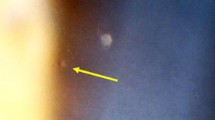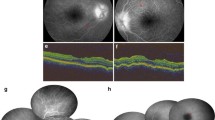Abstract
Purpose
To assess the levels of retinal and choroidal involvement in initial-onset birdshot retinochoroiditis (BRC) and Vogt–Koyanagi–Harada (VKH) disease, two stromal choroiditis entities.
Methods
This retrospective study included patients diagnosed with BRC and VKH, seen during initial-onset disease at the Centre for Ophthalmic Specialized Care, Lausanne, Switzerland. Angiographic signs were quantified, using an established dual fluorescein angiography (FA) and indocyanine green angiography (ICGA) scoring system for uveitis, and the FA/ICGA score ratios were compared between diseases.
Results
Among 1793 patients with uveitis seen from 1995 to 2015, 7 newly diagnosed BRC patients and 4 patients with newly diagnosed VKH disease had sufficient data for study inclusion. Patients with BRC and VKH at initial onset had mean FA angiographic scores of 16.91 ± 3.42 and 4.06 ± 1.87; mean ICGA angiographic scores of 21.34 ± 3.49 and 25.75 ± 3.88; and mean FA/ICGA ratios of 0.79 ± 0.21 and 0.16 ± 0.09, respectively.
Conclusion
This study showed the differential involvements of the retina and choroid in BRC and VKH. The choroid was preponderantly involved in both diseases; thus, ICGA is essential for disease assessment and follow-up. However, these diseases also differed substantially. The origin of inflammation was primarily in the choroid in VKH and in both the choroid and retina in BRC. We recommend dual FA and ICGA for evaluating posterior uveitis, when choroiditis is suspected.










Similar content being viewed by others
References
Brancato R, Trabucchi G (1998) Fluorescein and indocyanine green angiography in vascular chorioretinal diseases. Semin Ophthalmol 13:189–198
De Laey JJ (1996) Fluorescein angiography in posterior uveitis. Int Ophthalmol Clin 35:33–58
Herbort CP (2009) Fluorescein and indocyanine green angiography for uveitis. Middle East Afr J Ophthalmol 16:168–187
Herbort CP, Guex-Crosier Y, Le Hoang P (1994) Schematic interpretation of indocyanine green angiography. Ophthalmology 2:169–176
Herbort CP (1998) Posterior uveitis: new insights given by indocyanine green angiography. Eye 12:757–759
Herbort CP, Neri P, Abu El Asrar AA, Gupta V, Kestelyn P, Khairallah M, Mantovani A, Tugal-Tutkun I, Papadia M (2012) Is ICGA still relevant in inflammatory eye disorders? Why this question has to be dealt with separately from other eye conditions. Retina 32:1701–1703
Bouchenaki N, Cimino L, Auer C, Tran VT, Herbort CP (2002) Assessment and classification of choroidal vasculitis in posterior uveitis using indocyanine green angiography. Klin Monbl Augenheilkd 219:243–249
Cimino L, Auer C, Herbort CP (2000) Sensitivity of indocyanine green angiography for the follow-up of active inflammatory choriocapillaropathies. Ocul Immunol Inflamm 8:275–283
Bouchenaki N, Herbort CP (2004) Stromal choroiditis. In: Pleyer U, Mondino B (eds) Essentials in ophthalmology: uveitis and immunological disorders. Springer, Berlin, pp 234–253
Fardeau C, Herbort CP, Kullman N, Quentel GG, LeHoang P (1999) Indocyanine green angiography in birdshot chorioretinopathy. Ophthalmology 106:1928–1934
Bouchenaki N, Herbort CP (2001) The contribution of indocyanine green angiography to the appraisal and management of Vogt–Koyanagi–Harada disease. Ophthalmology 108:54–64
Tugal-Tutkun I, Herbort CP, Khairallah M (2010) Angiography Scoring for Uveitis Working Group (ASUWOG). Scoring of dual fluorescein and ICG inflammatory angiographic signs for the grading of posterior segment inflammation (dual fluorescein and ICG angiographic scoring system for uveitis). Int Ophthalmol 30:539–552
Tugal-Tutkun I, Herbort CP, Khairallah M, Mantovani A (2010) Interobserver agreement in scoring of dual fluorescein and ICG inflammatory angiographic signs for the grading posterior segment inflammation. Ocul Immunol Inflamm 18:385–389
Papadia M, Herbort CP Jr (2015) New concepts in the appraisal and management of birdshot retinochoroiditis: a global perspective. Int Ophthalmol 35:287–301
Papadia M, Herbort CP (2013) Reappraisal of birdshot retinochoroiditis (BRC): a global approach. Graefe’s Arch Clin Exp Ophthalmol 251:861–869
Knecht PB, Papadia M, Herbort CP (2014) Early and sustained treatment modifies the phenotype of birdshot retinochoroiditis. Int Ophthalmol 34:563–574
Knecht PB, Papadia M, Herbort CP (2013) Granulomatous keratic precipitates in birdshot retinochoroiditis. Int Ophthalmol 33:133–137
Papadia M, Herbort CP (2012) Indocyanine green angiography (ICGA) is essential for the early diagnosis of birdshot chorioretinopathy. Klin Monbl Augenheilkd 229:348–352
Reddy AK, Gonzalez MA, Henry CR, Yeh S, Sobrin L, Albini TA (2015) Diagnostic sensitivity of indocyanine green angiography for birdshot chorioretinopathy. JAMA Ophthalmol 133:840–843
Herbort CP, Mantovani A, Bouchenaki N (2007) Indocyanine green angiography in Vogt–Koyanagi–Harada disease: angiographic signs and utility in patient follow-up. Int Ophthalmol 27:173–182
Miyanaga M, Kawaguchi T, Miyata K, Horie S, Mochizuki M, Herbort CP (2010) Indocyanine gree angiography findings in initial acute pre-treatment Vogt–Koyanagi–Harada disease in Japanese patients. Jpn J Ophthalmol 54:377–382
Balci O, Gasc A, Jeannin B, Herbort CP (2016) Enhanced depth imaging is less suited than indocyanine green angiography for close monitoring of primary stromal choroiditis: a pilot study. Int Ophthalmol. doi:10.1007/s10792-016-0303-7
Abu El-Asrar A, Hemachandran S, Al-Mezaine HS, Kangave D, Al-Muammar AM (2012) The outcomes of mycophenolate mofetil therapy combined with systemic corticosteroids in acute uveitis associated with Vogt–Koyanagi–Harada disease. Acta Ophthalmol 90:603–608
Bouchenaki N, Herbort CP (2011) Indocyanine green angiography guided management of Vogt–Koyanagi–Harada disease. J Ophthalmic Vis Res 6:241–248
Kiss S, Ahmed M, Leiko E, Foster CS (2005) Long-term follow-up of patients with birdshot retinochoroidopathy treated with corticosteroid-sparing systemic immunomodulatory therapy. Ophthalmology 112:1066–1071
Cervantes-Castaneda RA, Gonzalez-Gonzalez LA, Cordero-Coma M et al (2013) Combined therapy of cyclosporine A and mycophenolate mofetil for the treatment of birdshot retinochoroidopathy: a 12-month follow-up. Br J Ophthalmol 97:637–643
de Courten C, Herbort CP (1998) Potential role of computerized visual field testing for the appraisal and follow-up of birdshot chorioretinopathy. Arch Ophthalmol 116:1389–1391
Thorne JE, Jabs DA, Kedhar SR et al (2008) Loss of visual field among patients with birdshot chorioretinopathy. Am J Ophthalmol 145:23–28
Papadia M, Jeannin B, Herbort CP (2012) OCT findings in birdshot chorioretinitis: a glimpse into retinal disease evolution. Ophthalmic Surg Lasers Imaging 43:25–31
Priem HA, Oosterhuis JA (1988) Birdshot chorioretinopathy: clinical characteristics and evolution. Br J Ophthalmol 72:646–659
Nakai K, Gomi F, Ikuno Y, Yasuno Y, Nouchi T, Ohguro N, Nishida K (2012) Choroidal observation in Vogt–Koyanagi–Harada disease using high-penetration optical coherence tomography. Graefe’s Arch Clin Exp Ophthalmol 250:1089–1095
Birnbaum AD, Fawzi AA, Rademaker A, Goldstein DA (2014) Correlation between clinical signs and optical coherence tomography with enhanced depth imaging findings in patients with birdshot retinochoroidopathy. JAMA Ophthalmol 132:929–935
Author information
Authors and Affiliations
Corresponding author
Ethics declarations
Conflict of interest
The authors declare that they have no conflict of interest.
Rights and permissions
About this article
Cite this article
Balci, O., Jeannin, B. & Herbort, C.P. Contribution of dual fluorescein and indocyanine green angiography to the appraisal of posterior involvement in birdshot retinochoroiditis and Vogt–Koyanagi–Harada disease. Int Ophthalmol 38, 527–539 (2018). https://doi.org/10.1007/s10792-017-0487-5
Received:
Accepted:
Published:
Issue Date:
DOI: https://doi.org/10.1007/s10792-017-0487-5




